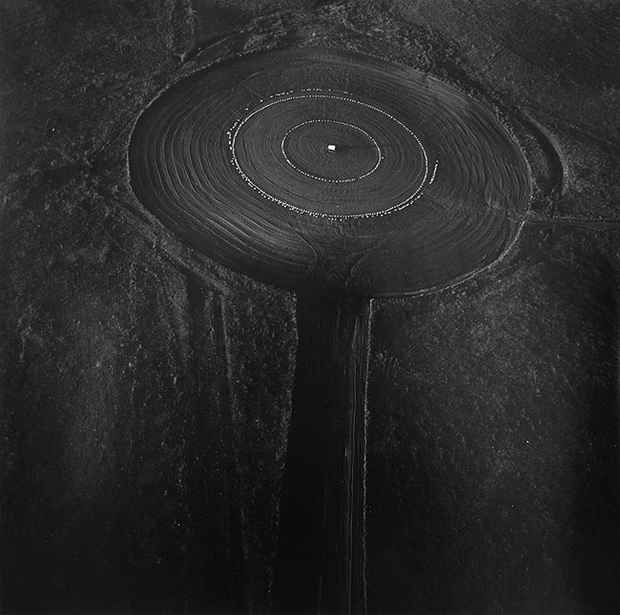Terry Evans “Inhabited Prairie”
Yancey Richardson Gallery

This event has ended.
Layers of use, layers of loss and recovery and loss again, vestiges. These photographs are neither a critique of land use nor a statement about the irony of its beauty. The photographs are not about abstract visual design; they are about specific places. They show marks that contain contradictions and mysteries that raise questions about how we live on the prairie. All of these places are beautiful to me, perhaps because all land, like the human body, is beautiful. - Terry Evans, The Inhabited Praire, 1998
Yancey Richardson Gallery presents Inhabited Prairie, an exhibition of vintage black and white aerial photographs taken by Terry Evans between 1990 and 1994, which explore the complexities and contradictions in America’s heartland, specifically the artist’s local landscape in her native Kansas. This particular region has a deep and varied history of use. For instance, Smoky Hill Weapons Range, the nation’s largest Air National Guard bombing site, is contained within fertile fields and agro-industrial lands, and is only a short distance from the Tallgrass Prairie Natural Preserve, the last uncultivated tallgrass prairie ecosystem in North America.
Having photographed the ecology of the prairie floor from ground level for several years, Evans determined that the story of the land was incomplete without a macroscopic perspective of what she described as the “disturbed, cultivated, militarized” prairie. In 1990, Evans began taking flights in a 25-mile radius around her home in Salina, Kansas, cataloguing the farms, flooded fields, cemeteries, ancient Indian village sites, highways, train tracks, bridges, military sites, cattle ranches and industrial gravel pits comprising the land below. Flying at 700 to 1000 feet, Evans could read specific pieces of visual information on the ground, without the entire landscape veering into abstraction. This distinction is critical to Evans’ practice, and it allowed for her unflinching look at the relationship between human intervention and the natural prairie. As Evans writes: “The thing I love the most was learning to read the landscape history from the air. I felt I was acquiring a sort of visual literacy of the ground. It was about reading the clues that told me whether or not the ground had ever been plowed, where the cemeteries were, what part was military, and what the history of all those markings meant.”
Richly toned and precisely detailed, Evans’ aerial views possess a rigorous formalism. They are starkly beautiful visual records of the land. Like Robert Adams, Evans takes an objective, sensitive and non-ironic stance toward the relationship between the people and the land. When Evans describes her process of “reading the clues” of the landscape, she posits what curator April M. Watson calls an “aesthetic neutrality.” In her essay As Above, So Below: The Humane Perspective of Terry Evans’s Aerial Landscapes, Watson suggests Evans’ aesthetic neutrality is neither condemnation nor glorification of the various military and agro-industrial practices which have reconfigured the land, but rather an “artistically conceived record” of the layers of history on the land.
Time is central to Evans’ consideration of the land, both as a fleeting moment and as an epoch. A river flooded over its banks, creating an oxbow in an adjacent field, will disappear into the ground in a matter of days; a family cemetery surrounded by tilled fields suggests generations of a farming family; an intersection of dirt roads overlays a Native American village site dating from hundreds of years before European settlement.
Combining both aerial and ground photography, Terry Evans (b. 1944) has photographed the prairies and plains of North America and the urban prairie of Chicago since the mid-1970s. She has recently completed a long-term project about the town of Matfield Green, Kansas and the surrounding Flint Hills. She is currently photographing the North Dakota oil boom in collaboration with writer and producer Elizabeth Farnsworth.
Evans has exhibited widely, including one-person shows at the Art Institute of Chicago, the Smithsonian National Museum of Natural History, and The Field Museum of Natural History. Her traveling museum retrospective Heartland opened at the Nelson-Atkins Museum of Art in Kansas City in 2012. She is a Guggenheim Fellow and a recipient of an Anonymous Was a Woman award. Several books have been published on her work including Prairie: Images of Ground and Sky, The Inhabited Prairie, Disarming the Prairie and Heartland. Her work is in major museum collections including the Art Institute of Chicago, Museum of Modern Art, N.Y., San Francisco Museum of Modern Art, Smithsonian American Art Museum, Whitney Museum of American Art, Corcoran Gallery of Art, and the Museum of Contemporary Photography, among many others.
[Image: Terry Evans “Weapons range target: September 30, 1990”]
Media
Schedule
from May 23, 2013 to July 03, 2013
Opening Reception on 2013-05-23 from 18:00 to 20:00